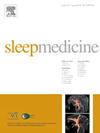Fatal familial insomnia: A new case description with response to thoracic sympathetic nerve thermocoagulation and stellate ganglion block
IF 3.8
2区 医学
Q1 CLINICAL NEUROLOGY
引用次数: 0
Abstract
Fatal familial insomnia (FFI) is a rare autosomal dominant neurodegenerative disorder characterized by rapidly progressive dementia, severe sleep disturbances, and autonomic dysfunction. The clinical manifestations of FFI can exhibit substantial variations, making it crucial to rule out other conditions, such as autoimmune encephalitis and Creutzfeldt-Jakob disease, during early diagnosis. In this study, we describe the case of a 58-year-old man who experienced persistent insomnia, autonomic symptoms, gait instability, and rapidly progressive dementia. Polysomnography revealed considerable alterations brain positron emission tomography/computed tomography showed no significant abnormal changes and cerebrospinal fluid analysis indicated a slight elevation in protein levels. Results of tests for autoimmune encephalitis antibodies were negative. The presence of the prion protein gene D178N mutation was confirmed through genetic testing and in conjunction with the patient's clinical manifestations, a diagnosis of FFI was established. Owing to severe autonomic neuropathy and intractable hyponatremia resulting from excessive sweating, therapeutic interventions, including thoracic sympathetic nerve thermocoagulation and stellate ganglion block, were attempted. These treatments initially led to symptomatic improvements, such as reduced sweating and amelioration of hyponatremia; however, sweating persisted, albeit to a lesser extent. Despite these interventions, the patient's condition deteriorated, leading to death 16 months after symptom onset owing to progressive agrypnia excitata, worsening dementia, and gait instability. This case underscores the current lack of effective treatments for FFI and highlights the urgent need for further research on this debilitating disorder.
求助全文
约1分钟内获得全文
求助全文
来源期刊

Sleep medicine
医学-临床神经学
CiteScore
8.40
自引率
6.20%
发文量
1060
审稿时长
49 days
期刊介绍:
Sleep Medicine aims to be a journal no one involved in clinical sleep medicine can do without.
A journal primarily focussing on the human aspects of sleep, integrating the various disciplines that are involved in sleep medicine: neurology, clinical neurophysiology, internal medicine (particularly pulmonology and cardiology), psychology, psychiatry, sleep technology, pediatrics, neurosurgery, otorhinolaryngology, and dentistry.
The journal publishes the following types of articles: Reviews (also intended as a way to bridge the gap between basic sleep research and clinical relevance); Original Research Articles; Full-length articles; Brief communications; Controversies; Case reports; Letters to the Editor; Journal search and commentaries; Book reviews; Meeting announcements; Listing of relevant organisations plus web sites.
 求助内容:
求助内容: 应助结果提醒方式:
应助结果提醒方式:


